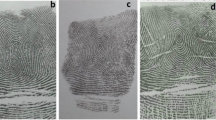Abstract
Two thousand and six hundred fifty years after the death of the “Girl of the Uchter Moor”, it was still possible to secure good-quality fingerprints from the right hand of this bog body by using photographic methods followed by image enhancement with an Automated Fingerprint Identification System. A detailed fingerprint analysis was performed, and all five fingers of “Moora's” right hand exhibited ulnar loops. Even today, this is still the most common fingerprint pattern type in Europe. It was also possible to find enough minutiae on the right thumb for secure dactyloscopic identification after more than 2,000 years. The example of “Moora" therefore demonstrates new possibilities for future fingerprint examinations of ancient bodies in archaeological as well as forensic casework.












Similar content being viewed by others
Notes
The camera used to take the photographs of the fingers was a Nikon D80 with 50-, 100- and 200-mm macro lenses. A 50-mm/f1.8 portrait lens with +6 close-up lenses was also used. The images were produced with 10 Megapixel/raw.
A Nikon SB-800 was used.
The PhotoShop program, version CS3 Extended, from Adobe, and the image processing routines of the DERMALOG AFIS, version 3.1, were used for processing.
References
Asingh P, Lynnerup N (2007) Grauballe Man. An Iron Age bog body revisited. Moesgaard Museum, Jutland Archaeological Society
Crooks HE (1953) Photography of epidermal ridges and superficial blood capillaries of the fingers. Med Biol Illus 3:198–201
Cummins H, Midlo C (1943) Finger prints, palms and soles. Philadelphia, Blakiston
Cummins H, Steggerda M (1935) Fingerprints in a Dutch family series. Am J Phys Anthrop, 19–41
D´ Anastasio R, Vezzosi A, Gallenga PE, Pierfelice L, Sabato A, Capasso L (2005) Anthropological analysis of Leonardo da Vinci´s fingerprints. ANTHROPOLOGIE, Vol. XLIII/1, Moravian Museum, Brno, Czech Republic, pp 57–61
Dennis RLH, Sunderland E (1979) Dermatoglyphic variation in the human populations of the north Pennine Dales, North England. 1. Sex differences, bilateral asymmetry, digital diversity and regional variation. Am J Phys Anthrop 50:309–324
DERMALOG Identification Systems GmbH (2007) DERMALOG AFIS User manual. Hamburg
Galton F (1892) Finger prints. MacMillan and Co, London
Galton F (1895) Fingerprint directories. MacMillan and Co, London
Hauser G, Mull G (1988) Methoden zur Dokumentation von Hautleisten und -furchen. In: Knußmann R (ed) Anthropologie – Handbuch der vergleichenden Biologie des Menschen. Stuttgart, New York, pp 497–507
Holt SB (1968) The genetics of dermal ridges. Charles C Thomas, Springfiel, Illinois
Karev G (1986) Digital dermatoglyphics of Bulgarians from northeast Bulgaria. Am J Phys Anthrop 69(37):37–50
Liu YF, Li H, Jin JZ, Jin L (2004) Exploration of dermatoglyphic statistics based on analysis of Leme in Bai nationality. J Genet Mol Biol 15(1):35–44
Loeffler L (1969) Papillarleisten und Hautfurchensystem. In: Becker PW (ed.) Humangenetik, Bd. I/2: Stuttgart, pp 205–408
Loesch D (1983) Quantitative dermatoglyphics. Classification, genetics, and pathology. Oxford University Press, New York
Matsuda E (1973) Genetic studies on total finger ridge-count among Japanese. Jinrui Idengaku Zasshi 17(4):293–318
Mull G (1983) Untersuchungen über die Vererbung von Leistenmerkmalen auf den Fingerbeeren unter Verwendung eines neu entwickelten optischen Gerätes. Universität Hamburg, Magisterarbeit
Oppermann K (2000) Der daktyloskopische Identitätsnachweis. Kriminalwissenschaftliche Abh 29, Lübeck
Qutub H, Qazi H, Mapa C, Woods J (1977) Dermatoglyphics of American blacks. Am J Phys Anthrop 47:483–488
Schade H (1969) Allgemeine Morphologie des Hautleistensystems. In: Hirsch W (ed.) Hautleisten und Krankheiten. Berlin
Tietze S, Witthuhn K (2001) Papillarleistenstruktur der menschlichen Handinnenfläche. Polizei und Forsch 9; Wiesbaden
TOLLUND MAN Home Page: http://www.tollundman.dk/fingeraftryk.asp (zuletzt aufgerufen am 16.01.2008)
Wertelecki W, Plato CC, Paul NW (1979) Dermatoglyphics—fifty years later. Alan R Liss, New York
Author information
Authors and Affiliations
Corresponding author
Rights and permissions
About this article
Cite this article
Mull, G., Püschel, K. & Jopp, E. Fingerprint identification on a bog body (650 BC). Archaeol Anthropol Sci 3, 201–207 (2011). https://doi.org/10.1007/s12520-011-0053-4
Received:
Accepted:
Published:
Issue Date:
DOI: https://doi.org/10.1007/s12520-011-0053-4




